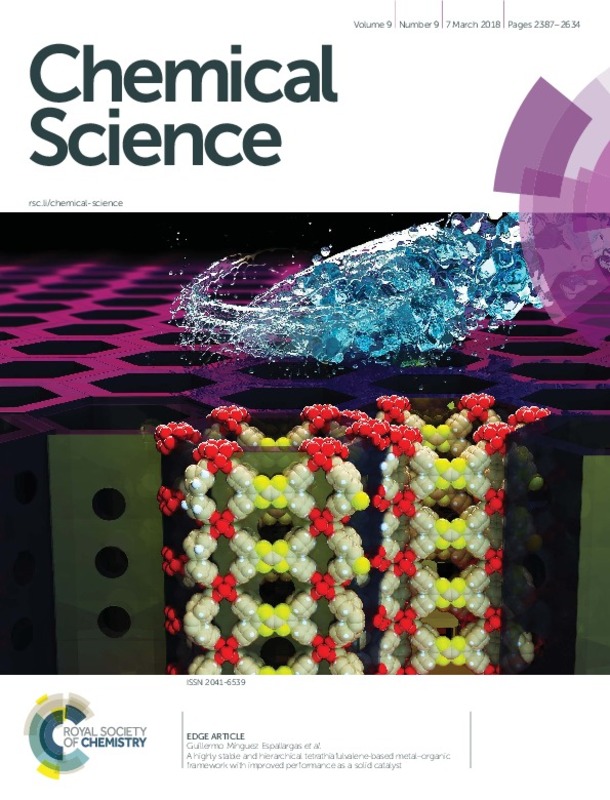Furukawa, H., Cordova, K. E., O’Keeffe, M., & Yaghi, O. M. (2013). The Chemistry and Applications of Metal-Organic Frameworks. Science, 341(6149), 1230444-1230444. doi:10.1126/science.1230444
Zhou, H.-C. «Joe», & Kitagawa, S. (2014). Metal–Organic Frameworks (MOFs). Chem. Soc. Rev., 43(16), 5415-5418. doi:10.1039/c4cs90059f
Maurin, G., Serre, C., Cooper, A., & Férey, G. (2017). The new age of MOFs and of their porous-related solids. Chemical Society Reviews, 46(11), 3104-3107. doi:10.1039/c7cs90049j
[+]
Furukawa, H., Cordova, K. E., O’Keeffe, M., & Yaghi, O. M. (2013). The Chemistry and Applications of Metal-Organic Frameworks. Science, 341(6149), 1230444-1230444. doi:10.1126/science.1230444
Zhou, H.-C. «Joe», & Kitagawa, S. (2014). Metal–Organic Frameworks (MOFs). Chem. Soc. Rev., 43(16), 5415-5418. doi:10.1039/c4cs90059f
Maurin, G., Serre, C., Cooper, A., & Férey, G. (2017). The new age of MOFs and of their porous-related solids. Chemical Society Reviews, 46(11), 3104-3107. doi:10.1039/c7cs90049j
Sumida, K., Rogow, D. L., Mason, J. A., McDonald, T. M., Bloch, E. D., Herm, Z. R., … Long, J. R. (2011). Carbon Dioxide Capture in Metal–Organic Frameworks. Chemical Reviews, 112(2), 724-781. doi:10.1021/cr2003272
Mínguez Espallargas, G., & Coronado, E. (2018). Magnetic functionalities in MOFs: from the framework to the pore. Chemical Society Reviews, 47(2), 533-557. doi:10.1039/c7cs00653e
Rogge, S. M. J., Bavykina, A., Hajek, J., Garcia, H., Olivos-Suarez, A. I., Sepúlveda-Escribano, A., … Gascon, J. (2017). Metal–organic and covalent organic frameworks as single-site catalysts. Chemical Society Reviews, 46(11), 3134-3184. doi:10.1039/c7cs00033b
Ferey, G. (2005). A Chromium Terephthalate-Based Solid with Unusually Large Pore Volumes and Surface Area. Science, 309(5743), 2040-2042. doi:10.1126/science.1116275
Horcajada, P., Surblé, S., Serre, C., Hong, D.-Y., Seo, Y.-K., Chang, J.-S., … Férey, G. (2007). Synthesis and catalytic properties of MIL-100(Fe), an iron(iii) carboxylate with large pores. Chem. Commun., (27), 2820-2822. doi:10.1039/b704325b
Wang, K., Feng, D., Liu, T.-F., Su, J., Yuan, S., Chen, Y.-P., … Zhou, H.-C. (2014). A Series of Highly Stable Mesoporous Metalloporphyrin Fe-MOFs. Journal of the American Chemical Society, 136(40), 13983-13986. doi:10.1021/ja507269n
Yue, Y., Fulvio, P. F., & Dai, S. (2015). Hierarchical Metal–Organic Framework Hybrids: Perturbation-Assisted Nanofusion Synthesis. Accounts of Chemical Research, 48(12), 3044-3052. doi:10.1021/acs.accounts.5b00349
Li, L., Xiang, S., Cao, S., Zhang, J., Ouyang, G., Chen, L., & Su, C.-Y. (2013). A synthetic route to ultralight hierarchically micro/mesoporous Al(III)-carboxylate metal-organic aerogels. Nature Communications, 4(1). doi:10.1038/ncomms2757
Cai, G., & Jiang, H.-L. (2016). A Modulator-Induced Defect-Formation Strategy to Hierarchically Porous Metal-Organic Frameworks with High Stability. Angewandte Chemie International Edition, 56(2), 563-567. doi:10.1002/anie.201610914
Bueken, B., Van Velthoven, N., Willhammar, T., Stassin, T., Stassen, I., Keen, D. A., … Bennett, T. D. (2017). Gel-based morphological design of zirconium metal–organic frameworks. Chemical Science, 8(5), 3939-3948. doi:10.1039/c6sc05602d
Koo, J., Hwang, I.-C., Yu, X., Saha, S., Kim, Y., & Kim, K. (2017). Hollowing out MOFs: hierarchical micro- and mesoporous MOFs with tailorable porosity via selective acid etching. Chemical Science, 8(10), 6799-6803. doi:10.1039/c7sc02886e
Mondloch, J. E., Bury, W., Fairen-Jimenez, D., Kwon, S., DeMarco, E. J., Weston, M. H., … Hupp, J. T. (2013). Vapor-Phase Metalation by Atomic Layer Deposition in a Metal–Organic Framework. Journal of the American Chemical Society, 135(28), 10294-10297. doi:10.1021/ja4050828
Gómez-Paricio, A., Santiago-Portillo, A., Navalón, S., Concepción, P., Alvaro, M., & Garcia, H. (2016). MIL-101 promotes the efficient aerobic oxidative desulfurization of dibenzothiophenes. Green Chemistry, 18(2), 508-515. doi:10.1039/c5gc00862j
Martín, N. (2013). Tetrathiafulvalene: the advent of organic metals. Chemical Communications, 49(63), 7025. doi:10.1039/c3cc00240c
Wang, H.-Y., Cui, L., Xie, J.-Z., Leong, C. F., D’Alessandro, D. M., & Zuo, J.-L. (2017). Functional coordination polymers based on redox-active tetrathiafulvalene and its derivatives. Coordination Chemistry Reviews, 345, 342-361. doi:10.1016/j.ccr.2016.10.011
Wang, H.-Y., Ge, J.-Y., Hua, C., Jiao, C.-Q., Wu, Y., Leong, C. F., … Zuo, J.-L. (2017). Photo- and Electronically Switchable Spin-Crossover Iron(II) Metal-Organic Frameworks Based on a Tetrathiafulvalene Ligand. Angewandte Chemie International Edition, 56(20), 5465-5470. doi:10.1002/anie.201611824
Sun, L., Campbell, M. G., & Dincă, M. (2016). Electrically Conductive Porous Metal-Organic Frameworks. Angewandte Chemie International Edition, 55(11), 3566-3579. doi:10.1002/anie.201506219
Narayan, T. C., Miyakai, T., Seki, S., & Dincă, M. (2012). High Charge Mobility in a Tetrathiafulvalene-Based Microporous Metal–Organic Framework. Journal of the American Chemical Society, 134(31), 12932-12935. doi:10.1021/ja3059827
Park, S. S., Hontz, E. R., Sun, L., Hendon, C. H., Walsh, A., Van Voorhis, T., & Dincă, M. (2015). Cation-Dependent Intrinsic Electrical Conductivity in Isostructural Tetrathiafulvalene-Based Microporous Metal–Organic Frameworks. Journal of the American Chemical Society, 137(5), 1774-1777. doi:10.1021/ja512437u
Park, S. S., Hendon, C. H., Fielding, A. J., Walsh, A., O’Keeffe, M., & Dincă, M. (2017). The Organic Secondary Building Unit: Strong Intermolecular π Interactions Define Topology in MIT-25, a Mesoporous MOF with Proton-Replete Channels. Journal of the American Chemical Society, 139(10), 3619-3622. doi:10.1021/jacs.6b13176
Feng, D., Wang, K., Wei, Z., Chen, Y.-P., Simon, C. M., Arvapally, R. K., … Zhou, H.-C. (2014). Kinetically tuned dimensional augmentation as a versatile synthetic route towards robust metal–organic frameworks. Nature Communications, 5(1). doi:10.1038/ncomms6723
Liu, K., Li, H., Zhang, X., Shi, W., & Cheng, P. (2015). Constraining and Tuning the Coordination Geometry of a Lanthanide Ion in Metal–Organic Frameworks: Approach toward a Single-Molecule Magnet. Inorganic Chemistry, 54(21), 10224-10231. doi:10.1021/acs.inorgchem.5b01356
Li, H., Shi, W., Zhao, K., Niu, Z., Li, H., & Cheng, P. (2013). Highly Selective Sorption and Luminescent Sensing of Small Molecules Demonstrated in a Multifunctional Lanthanide Microporous Metal-Organic Framework Containing 1D Honeycomb-Type Channels. Chemistry - A European Journal, 19(10), 3358-3365. doi:10.1002/chem.201203487
Llewellyn, P. L., Bourrelly, S., Serre, C., Vimont, A., Daturi, M., Hamon, L., … Férey, G. (2008). High Uptakes of CO2and CH4in Mesoporous MetalOrganic Frameworks MIL-100 and MIL-101. Langmuir, 24(14), 7245-7250. doi:10.1021/la800227x
Palomino, M., Corma, A., Rey, F., & Valencia, S. (2010). New Insights on CO2−Methane Separation Using LTA Zeolites with Different Si/Al Ratios and a First Comparison with MOFs. Langmuir, 26(3), 1910-1917. doi:10.1021/la9026656
Xiang, S., He, Y., Zhang, Z., Wu, H., Zhou, W., Krishna, R., & Chen, B. (2012). Microporous metal-organic framework with potential for carbon dioxide capture at ambient conditions. Nature Communications, 3(1). doi:10.1038/ncomms1956
[-]









